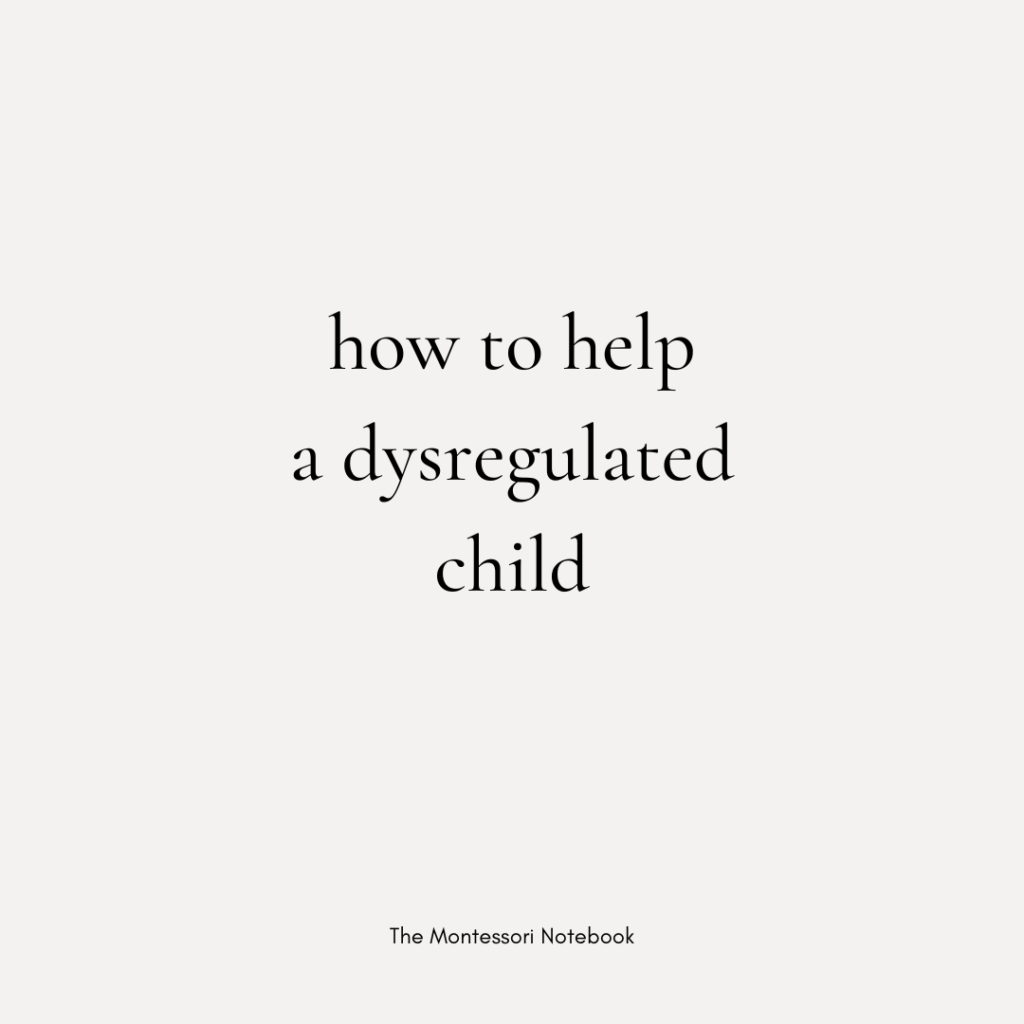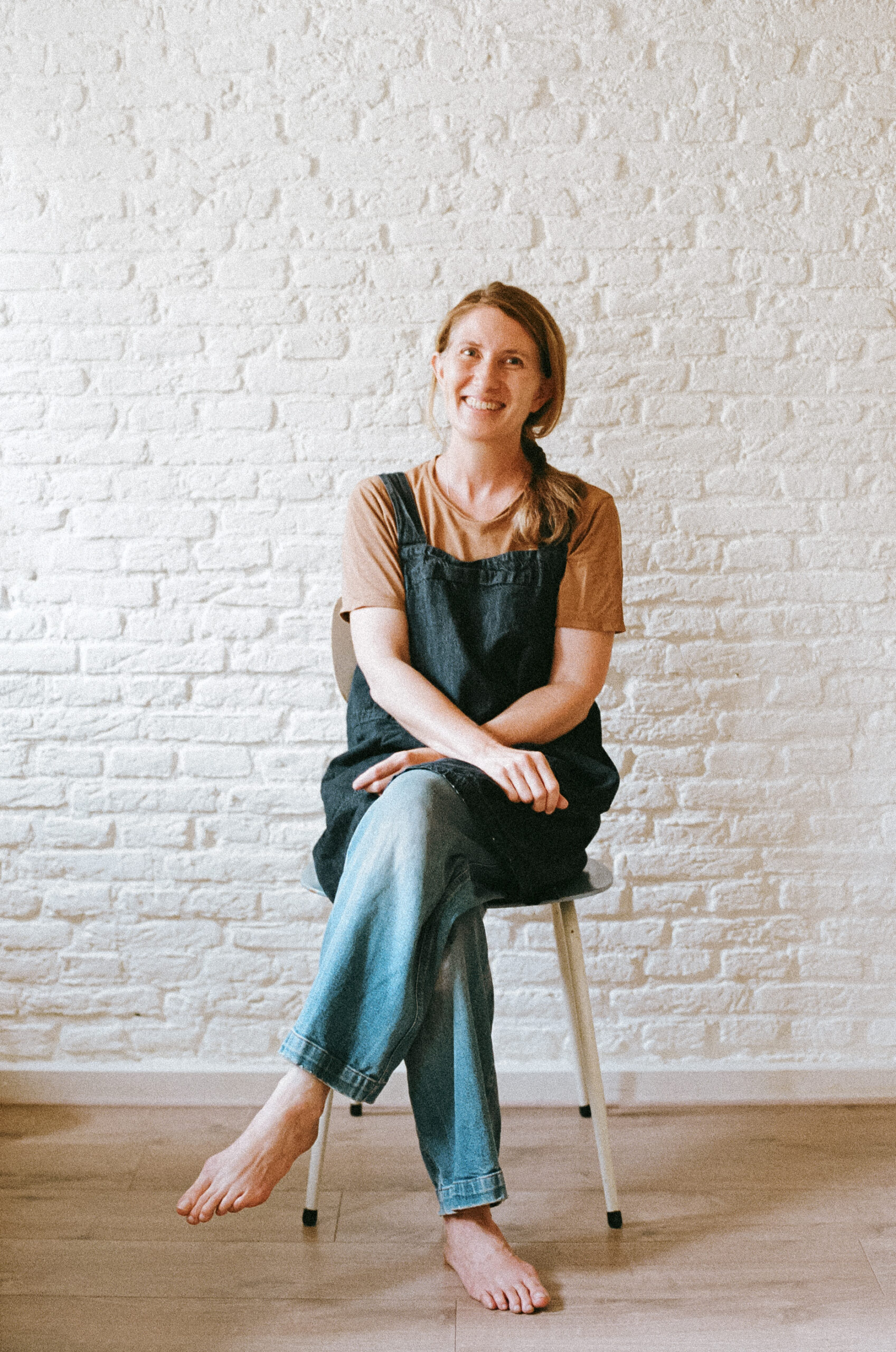How to help a dysregulated child

Ok, I have to admit it. I love the word dysregulated. It has only been on my radar the last year or two, but it’s been a game changer. Saying that I’m feeling dysregulated feels SO much better than saying that I’m in a bad mood or feeling cranky or disconnected. I can use it even when I don’t really know what I’m feeling, just not feeling myself. And allows us not to judge and instead to help a dysregulated child.
The word dysregulated doesn’t judge. It acknowledges that we move in and out of calm, balanced, regulated states. We won’t be able to be calm all the time. But we can learn ways that work for us to come back to a regulated state.
And we can do the same with our children. Instead of our child being “bad”, “challenging,” “defiant,” or “giving us a hard time,” they are often telling us they are feeling dysregulated. As their guides, we can help them feel these big feelings, come back to calm, and then make any repairs needed.
What is dysregulation?
“When an individual’s stress levels are too high various systems for thinking and metabolic recovery are compromised. The signs of dysregulation show up in the behaviour, or mood, or attention, and physical well-being.” – Dr Stuart Shanker
I’m definitely no expert but the way I understand it is that when we feel safe and open to connection, we are in a regulated state. We feel pretty balanced, receptive, and can concentrate and focus well.
At the same time, our body is constantly scanning for danger to keep us safe. When we sense something that we see as a threat, it triggers an alarm state (fight, flight, freeze or fawn) and we become dysregulated. The threat could be a tiger in the living room or it could be getting a sudden surprise, a dog barking near us, hurting ourselves, something not going as we expected, an old emotional wound being rubbed, or a disapproving look from someone. Or it could indeed be a real emergency.
As a Montessori educator, here are some ways I’ve seen dysregulation show up in children:
- getting upset or anxious
- having a tantrum
- hiding behind our leg as they enter a new situation
- being “sensitive” or easily activated by others or something in the environment
- being aggressive
- not responding, shutting down
- people pleasing
- etc…
It doesn’t always have to be big and loud. They may become very quiet or shut down too.
What we can do to help our child when they become dysregulated
If our child is not dysregulated in a big way but we notice that they are easily upset today, getting into a long uninterrupted period of play/work can help them come back to regulation. When they get into flow, their system begins to regulate itself.
When emotions are bigger…
1. Help them feel safe and to come back to calm
Reduce the stress/remove the danger where possible. If they feel in danger, we can remove them to somewhere that feels safe for them. For example, we could help them to move somewhere where they have more space if they feel cornered or to somewhere they can view what’s going on if they feel like there is a lot going on around them; they might want to take distance from a dog to where they can observe it safely; in case of emergency, move to safety etc.
Reassure them they are safe. Once any danger has been removed, let them know they are safe. “You’re safe. I’m here.” “You’re safe. I love you.” “There are people making sure that we are as safe as we can be.”
Lend them our nervous system. When everything else feels big, we can find our centre/our calm and lend it to them. I like to visualise taking them into my safe bubble. It also works with other adults who are activated and dysregulated.
Find ways that help them come back to a regulated state. They might:
- allow us to co-regulate, e.g, allow us to give them a cuddle, rub their back, breathe together choose to take themselves to their room when they are upset
- especially with little ones, if they push us away, observe to keep them safe at a little distance – offer a pillow if they are banging themselves or other, remind them regularly that we are here if they need us “I’m here if you’d like a hug” “I’m here if you need me”
- an older child (2.5+ years) might choose to go to their calm place, a cosy place that’s been set up in the home that they like to go when they are dysregulated which has some of their favourite things like books, trains, soft toys etc – this is different to time out as they go there willingly and come out when they feel ready; we can go there together; or we can go there if they don’t want to
- rock or sway their body or hum
- move their body (e.g., jumping jacks, running, cleaning)
- do a breathing exercise (e.g., breathe in, smell the flower, breathe out, blow out the candle; or for an older child, breathe in for three seconds, hold for three seconds, breathe out for six seconds, until calm)
- be able to locate where they feel the emotion in their body – sometimes finding the place is enough for them to help it release, or they can shake it out move, etc.
- an older child may be able to look for 5 things they can see, 4 things they can touch, 3 things they can hear, 2 things they can smell and 1 thing they can taste
- other – they may have other ways that work for them like listening to an audio book etc.
2. Then help them make any repair necessary
Repairs are important if they broke something, said something hurtful, hurt someone, or there was other harm. A repair is important not only for the person that was hurt but also for our child to resolve any guilt, shame or other feelings that they will otherwise hold onto.
They will need to be calm again before this step, so make sure they are feeling safe or there is unlikely to be an authentic repair.
We don’t have to force an apology (maybe something for another newsletter!) but we can show them how to make it up to the other person or how to repair an object. If another child is hurt, we might show them to get a wet cloth for them or a tissue for their tears. We can model apologising, “I’m sorry my child hurt you. Are you ok? Can I get you something?” Older children will be able to come up with ideas themselves and we can help them follow through, for example, calling another child to apologise, make them a card, or pick some flowers for them.
3. Build any lagging skills for the next time
We are doing our best to accept our child as they are AND we can help them build the skills they may need to manage a similar situation next time. This skill building takes place in the following days, not when emotions may still be tender.
If entering a classroom makes them nervous, we can practice greeting the teacher or finding another way to connect with them. If they find a group singing happy birthday loudly too much, we can show them how to cover their ears. If they have trouble managing their anger when things don’t go their way, we can brainstorm some ways with them that help them diffuse their anger more peacefully or without hurting themselves, others or the environment.
4. Hold limits
None of this means that we have to allow our chid anything they want. It means that we are holding the space for them to come back to regulation, not that we give in to demands that we don’t agree with. We can still be kind, and be clear.
Learning to regulate ourselves
As the adult, we can also learn what works for us when we get dysregulated. We might like to talk with a friend, clean the house, go for a run, be by ourselves, breath into the place in our body where we feel the emotion, get out of the house, journal, etc. I’d love to know what works for you.
A big piece of being able to show up as a mostly regulated adult is taking preventative measures too – looking after our health, finding ways to get enough sleep, being out in nature, meditating, yoga, running, spending time with friends, etc.
Knowing both how we start the day calm and balanced, and how we find our way back to calm so we can help our children when they are dysregulated, are important tools on this journey. And, you guessed it, we are also modelling these skills for our children…who are watching and learning from us.
More resources
- Self-Reg: How to Help Your Child (and You) Break the Stress Cycle and Successfully Engage with Life, Stuart Shanker
- Anchored: How to Befriend Your Nervous System Using Polyvagal Theory, Deb Dana
- Tilt Parenting podcast – the last season had so many great interviews about regulation, highly recommend
Before I go, I have a theory about Montessori and regulation
Dr Montessori talked about hands-on activities especially practical life activities being very useful for “normalisation,” the state when we observe the child is calm, focused and engaged. Whilst I’ve never been a big fan of the word “normalisation” – what even is normal? – I hazard to guess that what Dr Montessori termed “normalisation” was seeing the child in a regulated state.
My theory goes a little further. The more we are in a regulated state, the less things seem to pull us off centre, and when they do, the easier it is to come back to regulation. So if children in a Montessori classroom or home are able to get into a more regulated state from being in engaged play/work, these children are then perhaps more likely to be calm and peaceful, and know how to get back to a regulated state when life happens.
Just a theory! But if there are any researchers out there, it would be pretty cool to see if Montessori indeeds helps regulate our children.
The Montessori Show – all about Self-Regulation and Montessori

Simone Davies has more than 20 years’ experience as an AMI Montessori educator. Simone is the author of “The Montessori Toddler” and co-author of “The Montessori Baby” and “The Montessori Child” books, comprehensive guides to raising children in a Montessori way. She currently runs parent-child Montessori classes in Amsterdam at her school Jacaranda Tree Montessori. She also has a popular blog, instagram and podcast “The Montessori Notebook” and is mother to two young adults.